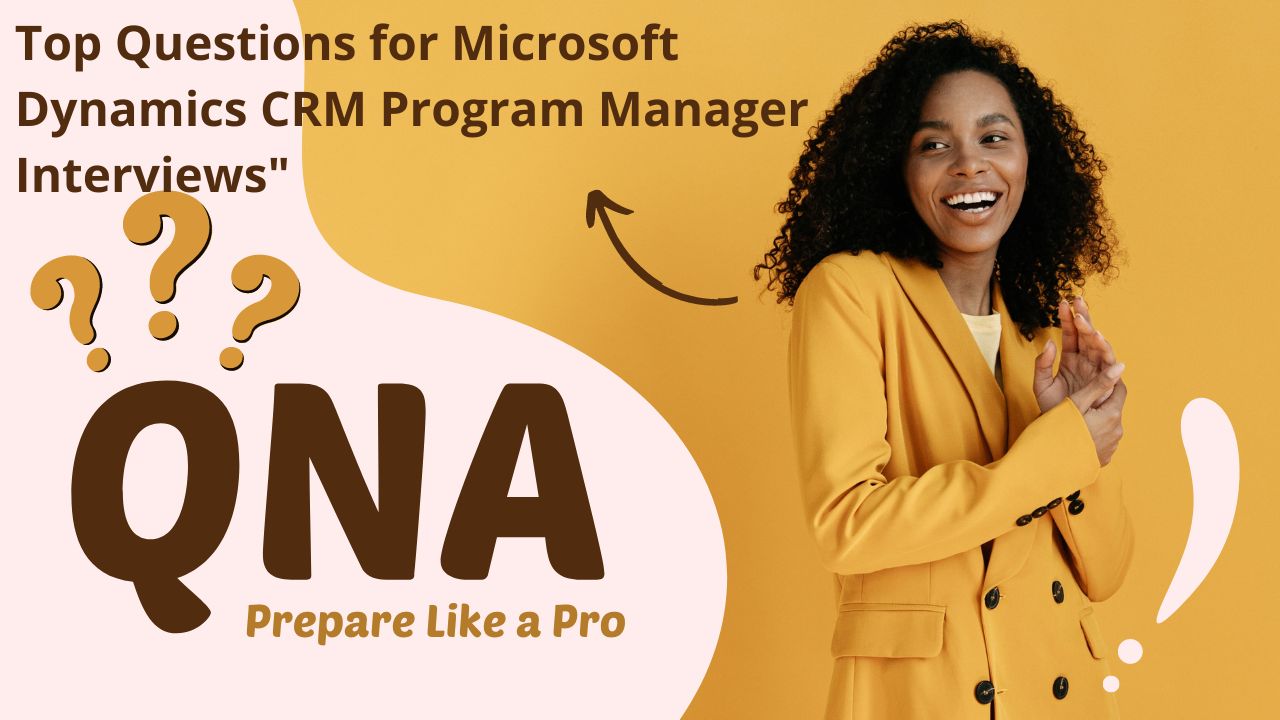Landing a role as a Microsoft Dynamics CRM Program Manager is a significant step in your career, demanding a robust understanding of CRM technologies, project management skills, and strategic thinking. Whether you’re just stepping into the field or looking to advance your career, preparing for the interview can be a daunting task. Our comprehensive guide, “Ace Your Microsoft Dynamics CRM Program Manager Interview,” provides you with the top 50 questions and expert-crafted answers to help you navigate the complex landscape of Dynamics CRM project management. From technical nuances to strategic planning and stakeholder communication, this guide is designed to give you the insights and confidence needed to excel in your interview.
In this blog, we dive deep into the essential areas of expertise required for a Microsoft Dynamics CRM Program Manager. You’ll learn how to articulate your experience with managing CRM implementations, handling data migrations, and ensuring project alignment with business objectives. Our detailed Q&A format covers every facet of the interview process, including technical skills, project governance, risk management, and team leadership. This resource not only prepares you for the questions you might face but also enhances your understanding of how to leverage Dynamics CRM to drive business success. Whether you’re aiming to impress hiring managers or looking to polish your interview skills, our guide is your go-to resource for mastering the Dynamics CRM Program Manager role.
Table of Contents
Microsoft Dynamics CRM Interview Questions
1. What is Microsoft Dynamics CRM and what are its core functionalities?
Microsoft Dynamics CRM is a customer relationship management software developed by Microsoft, designed to improve business relationships with customers, enhance sales, streamline processes, and increase profitability. Core functionalities include:
- Sales: Managing the sales process and customer interactions.
- Customer Service: Facilitating case management and support.
- Marketing: Campaign management and marketing automation.
- Field Service: Coordinating field operations and service delivery.
- Project Service Automation: Managing project-based activities.

2. Can you explain the architecture of Microsoft Dynamics CRM?
Microsoft Dynamics CRM architecture comprises several layers:
- Presentation Layer: User interface accessible via web, mobile, and Outlook integration.
- Application Layer: Core business logic and CRM services.
- Data Access Layer: Manages communication with the database.
- Integration Layer: Connects with external applications through APIs and services.
- Database Layer: Stores CRM data using SQL Server.
3. How does Microsoft Dynamics CRM support integration with other systems?
Microsoft Dynamics CRM supports integration through:
- Web APIs: RESTful services for interacting with CRM data.
- Azure Integration Services: Enables complex integrations using Azure Logic Apps, Service Bus, and Functions.
- Common Data Service (CDS): Allows data integration across Dynamics 365 applications.
- Third-party connectors: Such as Power Automate for workflow automation.
4. What is the role of the Common Data Service (CDS) in Dynamics 365?
The Common Data Service (CDS) is a data platform that underpins Dynamics 365 applications, enabling data unification and interoperability across various business applications. It provides:
- Standardized data schema: Common data model across different apps.
- Secure data storage: Managed in Microsoft’s cloud.
- Data integration: Facilitates data exchange between Dynamics 365 and external systems.
5. Explain the difference between a workflow and a business process flow in Dynamics CRM.
- Workflow: Automated processes that can be triggered by system events or manually to perform tasks like sending emails, updating records, or managing approvals.
- Business Process Flow: A guided, visual representation of steps needed to complete a process (e.g., lead to opportunity) across multiple stages and entities.
6. What are plugins in Microsoft Dynamics CRM and how do they work?
Plugins in Dynamics CRM are custom business logic (code) that can be executed in response to events triggered by CRM actions (e.g., creating or updating records). They work by:
- Event registration: Attached to specific messages and entities.
- Execution: Runs synchronously or asynchronously during the specified events.
- Contextual data access: Plugins can access and modify data in the CRM context they are triggered within.
7. Describe the security model in Microsoft Dynamics CRM.
The security model in Dynamics CRM is multi-faceted, including:
- Role-based security: Permissions are granted based on user roles.
- Record-based security: Access control at the record level, governed by ownership and sharing.
- Field-level security: Restricts access to specific fields.
- Hierarchy security: Provides access to records based on the managerial hierarchy.
8. What are the advantages of using Dynamics 365 CRM over a traditional on-premise CRM solution?
Advantages include:
- Cloud-based accessibility: Anytime, anywhere access with no need for on-premise servers.
- Scalability: Easy to scale up or down based on business needs.– Need to Rephrase – it should be uniuqe
- Integration: Seamless integration with other Microsoft services (e.g., Office 365, Azure).
- Regular updates: Automatic updates and new features with minimal disruption.
- Lower IT overhead: Reduced costs associated with maintenance and infrastructure.
9. How do you manage data migration in Dynamics CRM projects?
Data migration involves:
- Assessment: Understanding data sources and structure.
- Mapping: Defining how source data maps to CRM entities.
- Data cleansing: Ensuring data quality before migration.
- Migration tools: Using tools like Dynamics 365 Data Import Wizard, KingswaySoft, or SSIS.
- Testing: Validating data accuracy post-migration.
- Documentation: Keeping records of the migration process and mapping.
10. Explain the concept of solutions in Microsoft Dynamics CRM.
Solutions in Dynamics CRM are packages of customizations and configurations that can be exported and imported across different environments. There are:
- Managed Solutions: Locked solutions that restrict changes and protect intellectual property.
- Unmanaged Solutions: Editable solutions that are ideal for development and testing environments.
Salesforce Interview Questions
1. What is Salesforce and what are its main components?
Salesforce is a cloud-based customer relationship management (CRM) platform. Its main components include:
- Sales Cloud: Manages sales processes and customer interactions.
- Service Cloud: Facilitates customer support and service management.
- Marketing Cloud: Supports digital marketing campaigns and automation.
- Commerce Cloud: E-commerce solutions for managing online sales.
- Community Cloud: Builds and manages customer and partner communities.
- AppExchange: Marketplace for third-party apps and components.
2. Describe the architecture of Salesforce.
Salesforce architecture consists of:
- Multitenant Cloud: Multiple customers share the same infrastructure with isolated data.
- Metadata-Driven Platform: Customizations and configurations are stored as metadata.
- APIs: Provide robust integration capabilities (REST, SOAP).
- Force.com Platform: Enables the development of custom applications using Apex and Visualforce.
- Lightning Framework: Modern UI and app development framework.
3. How does Salesforce ensure data security and compliance?
Salesforce ensures security through:
- Role-based security: Access control through profiles and permission sets.
- Data Encryption: Encryption at rest and in transit.– Need to Rephrase – it should be uniuqe
- Field-level security: Restricts access to sensitive data fields.– Need to Rephrase – it should be uniuqe
- Audit Trail: Tracks changes and access to data.
- Compliance Certifications: Adheres to standards like GDPR, HIPAA, and ISO 27001.
4. What is Salesforce Lightning and how does it differ from Salesforce Classic?
Salesforce Lightning is a modern UI and app development framework that enhances user experience and productivity. Differences include:
- User Interface: Lightning offers a more intuitive, responsive design.
- App Builder: Drag-and-drop tools for creating custom apps without code.
- Components: Reusable components for building dynamic pages.
- Performance: Optimized for mobile and faster performance.
- Transition: Some features in Classic are not available in Lightning, requiring users to migrate to Lightning for full functionality.
5. Can you explain what Salesforce Apex is and its role in the Salesforce platform?
Salesforce Apex is a strongly-typed, object-oriented programming language designed for developers to execute flow and transaction control statements on the Salesforce platform. It allows for:
- Custom logic: Building complex business logic.
- Triggers: Executing code in response to database events.
- Web services: Creating and invoking web services for integrations.
- Custom APIs: Exposing custom functionality via REST and SOAP APIs.
6. What are Salesforce Visualforce and Lightning components?
- Visualforce: A framework for building custom user interfaces using a tag-based markup language, integrated with Apex controllers for server-side logic.
- Lightning Components: Modern, reusable components for building dynamic web apps and mobile apps, leveraging the Lightning Component Framework.
7. How does Salesforce handle data integration and synchronization?
Salesforce supports data integration through:
- APIs: REST and SOAP APIs for real-time and batch integrations.
- Salesforce Connect: Allows external data access and management within Salesforce without data replication.
- Data Loader: Tool for bulk data import/export.
- Integration middleware: Tools like MuleSoft for complex integrations.
8. Describe the Salesforce data model and its key elements.
The Salesforce data model includes:
- Objects: Tables in the database (Standard and Custom Objects).
- Fields: Columns in the database table.
- Records: Rows in the database table.
- Relationships: Links between objects (Lookup and Master-Detail).
- Schema Builder: Visual tool for designing and viewing the data model.
9. What are the different types of reports in Salesforce, and how do they differ?
Salesforce offers:
- Tabular Reports: Simplest form, like a spreadsheet, showing data in rows and columns.
- Summary Reports: Grouped data with subtotals.
- Matrix Reports: Data summarized in a grid, grouped by rows and columns.
- Joined Reports: Multiple report blocks showing different data sets side by side.
10. How do you manage user roles and permissions in Salesforce?
User roles and permissions in Salesforce are managed through:
- Profiles: Define base level access to objects and fields.
- Permission Sets: Extend permissions granted by profiles.
- Role Hierarchies: Determine data access based on a user’s role.
- Sharing Rules: Provide exceptions to role-based access control.
- Field-level Security: Controls access to individual fields.
Comparing Microsoft Dynamics CRM and Salesforce
1. How do Microsoft Dynamics CRM and Salesforce differ in terms of deployment options?
- Microsoft Dynamics CRM: Offers both cloud-based (Dynamics 365) and on-premise deployment options, providing flexibility depending on organizational needs.
- Salesforce: Primarily a cloud-based solution with no on-premise option, emphasizing a SaaS model and rapid deployment.
2. Compare the user interface and customization capabilities of Dynamics CRM and Salesforce.
- Dynamics CRM: Offers a familiar interface for Microsoft users, with deep integration into the Microsoft ecosystem. Customizations are often more code-intensive but can be powerful and tailored.
- Salesforce: Features a modern, responsive UI with the Lightning Experience. Customizations are easier through the App Builder and Lightning Components, suitable for both admins and developers.
3. Discuss the integration capabilities of Dynamics CRM vs. Salesforce.
- Dynamics CRM: Leverages strong integration with Microsoft tools (e.g., Office 365, Azure) and supports broad third-party integrations through Power Platform and APIs.
- Salesforce: Boasts a robust ecosystem with AppExchange and powerful APIs for integration with various third-party services and internal systems.
4. How do Dynamics CRM and Salesforce handle scalability?
- Dynamics CRM: Offers scalability for both cloud and on-premise deployments. Cloud services can scale up with Microsoft’s Azure infrastructure.
- Salesforce: Scales seamlessly with its cloud-only architecture, supported by Salesforce’s robust data centers.
5. Compare the support and community resources available for Dynamics CRM and Salesforce users.
- Dynamics CRM: Supported by Microsoft’s extensive knowledge base, community forums, and partner networks. Regular updates and support through Microsoft’s enterprise services.
- Salesforce: Extensive resources through Trailhead for training, an active community, and a broad network of certified consultants and partners. Frequent updates and innovation through Salesforce’s platform services.
Dynamics CRM Project Manager Questions
1. What are the key responsibilities of a Dynamics CRM Project Manager?
Key responsibilities include:
- Project Planning: Defining scope, timelines, and resources.
- Stakeholder Management: Engaging and managing expectations of all stakeholders.
- Team Coordination: Leading and coordinating cross-functional teams.
- Risk Management: Identifying and mitigating project risks.
- Budget Management: Ensuring project stays within budget.
- Quality Assurance: Ensuring deliverables meet required standards.
- Communication: Regular updates to stakeholders on project progress.
2. How would you approach the customization and configuration of a Dynamics CRM solution for a new client?
Approach involves:
- Requirement Gathering: Detailed sessions with stakeholders to understand business needs.
- Gap Analysis: Comparing current processes with standard CRM capabilities.
- Customization Planning: Identifying necessary customizations (entities, workflows, plugins).
- Configuration: Setting up fields, forms, and dashboards.
- Testing: Rigorous testing to ensure customizations meet requirements.
- User Training: Providing end-user training and documentation.
- Deployment: Smooth transition to the live environment.
3. What are common challenges you face when implementing Dynamics CRM, and how do you overcome them?
Common challenges include:
- User Adoption: Overcome through thorough training and user-friendly customizations.
- Data Migration: Address by planning, data mapping, and validation processes.
- Integration Issues: Mitigate by involving technical teams early and using robust integration tools.
- Scope Creep: Control through clear scope definition and change management processes.
- Performance Issues: Address by optimizing configurations and scaling resources as needed.
4. How do you ensure data quality and integrity during a Dynamics CRM implementation?
Ensuring data quality involves:
- Data Cleansing: Removing duplicates, correcting inaccuracies before migration.
- Data Mapping: Accurate mapping of source data to CRM entities.
- Validation Rules: Implementing rules to enforce data integrity.
- Regular Audits: Scheduled audits to maintain ongoing data quality.
- Training: Educating users on best practices for data entry and management.
5. What strategies do you use for successful user adoption of Dynamics CRM?
Strategies for user adoption include:
- User Involvement: Engage users early in the project for feedback and testing.
- Comprehensive Training: Tailored training sessions and materials.
- User-Friendly Design: Intuitive interfaces and workflows.
- Change Management: Effective communication about changes and benefits.
- Support: Ongoing support and resources to assist users post-implementation.
Comparing Microsoft Dynamics CRM and Salesforce
1. How do Microsoft Dynamics CRM and Salesforce differ in terms of deployment options?
- Microsoft Dynamics CRM: Offers both cloud-based (Dynamics 365) and on-premise deployment options, providing flexibility depending on organizational needs.
- Salesforce: Primarily a cloud-based solution with no on-premise option, emphasizing a SaaS model and rapid deployment.
2. Compare the user interface and customization capabilities of Dynamics CRM and Salesforce.
- Dynamics CRM: Offers a familiar interface for Microsoft users, with deep integration into the Microsoft ecosystem. Customizations are often more code-intensive but can be powerful and tailored.
- Salesforce: Features a modern, responsive UI with the Lightning Experience. Customizations are easier through the App Builder and Lightning Components, suitable for both admins and developers.
3. Discuss the integration capabilities of Dynamics CRM vs. Salesforce.
- Dynamics CRM: Leverages strong integration with Microsoft tools (e.g., Office 365, Azure) and supports broad third-party integrations through Power Platform and APIs.
- Salesforce: Boasts a robust ecosystem with AppExchange and powerful APIs for integration with various third-party services and internal systems.
4. How do Dynamics CRM and Salesforce handle scalability?
- Dynamics CRM: Offers scalability for both cloud and on-premise deployments. Cloud services can scale up with Microsoft’s Azure infrastructure.
- Salesforce: Scales seamlessly with its cloud-only architecture, supported by Salesforce’s robust data centers.
5. Compare the support and community resources available for Dynamics CRM and Salesforce users.
- Dynamics CRM: Supported by Microsoft’s extensive knowledge base, community forums, and partner networks. Regular updates and support through Microsoft’s enterprise services.
- Salesforce: Extensive resources through Trailhead for training, an active community, and a broad network of certified consultants and partners. Frequent updates and innovation through Salesforce’s platform services.
Dynamics CRM Project Manager Questions
1. What are the key responsibilities of a Dynamics CRM Project Manager?
Key responsibilities include:
- Project Planning: Defining scope, timelines, and resources.
- Stakeholder Management: Engaging and managing expectations of all stakeholders.
- Team Coordination: Leading and coordinating cross-functional teams.
- Risk Management: Identifying and mitigating project risks.
- Budget Management: Ensuring project stays within budget.
- Quality Assurance: Ensuring deliverables meet required standards.
- Communication: Regular updates to stakeholders on project progress.
2. How would you approach the customization and configuration of a Dynamics CRM solution for a new client?
Approach involves:
- Requirement Gathering: Detailed sessions with stakeholders to understand business needs.
- Gap Analysis: Comparing current processes with standard CRM capabilities.
- Customization Planning: Identifying necessary customizations (entities, workflows, plugins).
- Configuration: Setting up fields, forms, and dashboards.
- Testing: Rigorous testing to ensure customizations meet requirements.
- User Training: Providing end-user training and documentation.
- Deployment: Smooth transition to the live environment.
3. What are common challenges you face when implementing Microsoft Dynamics CRM, and how do you overcome them?
Common challenges include:
- User Adoption: Overcome through thorough training and user-friendly customizations.
- Data Migration: Address by planning, data mapping, and validation processes.
- Integration Issues: Mitigate by involving technical teams early and using robust integration tools.
- Scope Creep: Control through clear scope definition and change management processes.
- Performance Issues: Address by optimizing configurations and scaling resources as needed.
4. How do you ensure data quality and integrity during a Microsoft Dynamics CRM implementation?
Ensuring data quality involves:
- Data Cleansing: Removing duplicates, correcting inaccuracies before migration.
- Data Mapping: Accurate mapping of source data to CRM entities.
- Validation Rules: Implementing rules to enforce data integrity.
- Regular Audits: Scheduled audits to maintain ongoing data quality.
- Training: Educating users on best practices for data entry and management.
5. What strategies do you use for successful user adoption of Microsoft Dynamics CRM?
Strategies for user adoption include:
- User Involvement: Engage users early in the project for feedback and testing.
- Comprehensive Training: Tailored training sessions and materials.
- User-Friendly Design: Intuitive interfaces and workflows.
- Change Management: Effective communication about changes and benefits.
- Support: Ongoing support and resources to assist users post-implementation.
Comparison: Salesforce vs. Microsoft Dynamics CRM
Here’s a detailed comparison between Salesforce and Microsoft Dynamics CRM across various parameters:
| Feature/Aspect | Salesforce | Microsoft Dynamics CRM |
|---|---|---|
| Deployment Options | Cloud-only (SaaS) | Cloud (Dynamics 365), On-Premise, Hybrid |
| User Interface | Modern, intuitive Lightning Experience; customizable with drag-and-drop tools (App Builder) | Familiar UI for Microsoft users; integrates deeply with Microsoft products (Office 365, Outlook) |
| Customization | Easy customization using no-code/low-code tools; Apex for advanced scripting | Deep customizations using Power Platform tools, Power Automate for workflows, and C# for advanced coding |
| Integration | Extensive API support (REST, SOAP); Salesforce Connect; AppExchange marketplace | Robust integration with Microsoft tools (Office 365, Azure); API support; connectors like Power Automate and Azure Logic Apps |
| Data Model | Flexible data model with standard and custom objects; Schema Builder for visual design | Entity-based model with customizable standard and custom entities; Common Data Service (CDS) for data unification |
| Automation | Workflow automation with Process Builder, Flow, and Apex triggers | Automation through Power Automate (formerly Microsoft Flow), workflows, and plugins |
| Security | Role-based security; field-level security; robust data encryption; audit trails | Multi-tier security with role-based access, field-level security, record-level security, and hierarchy security |
| Scalability | Highly scalable cloud infrastructure; supports large user bases and data volumes | Scalable in cloud (Dynamics 365 on Azure) and on-premise environments; flexible scaling options |
| Mobile Access | Salesforce1 mobile app with full functionality; optimized for mobile use | Dynamics 365 mobile app; responsive web interface; Office 365 mobile integration |
| Reporting & Analytics | Built-in analytics with customizable reports and dashboards; Einstein Analytics for advanced AI-driven insights | Advanced reporting with Power BI integration; in-built reporting tools and dashboards; AI insights with Dynamics 365 AI |
| Development Environment | Apex for backend development; Visualforce for UI; Lightning Components for modern apps | .NET-based development with C# for plugins; JavaScript for client-side scripting; Power Apps for no-code/low-code solutions |
| Community & Ecosystem | Strong ecosystem with AppExchange; extensive training via Trailhead; vibrant community support | Integrated with Microsoft ecosystem (Azure, Office 365); extensive community forums and support; ISV solutions through AppSource |
| Artificial Intelligence (AI) | Salesforce Einstein for AI-powered insights, predictive analytics, and automation | Dynamics 365 AI for predictive insights, customer service, and sales intelligence; Azure AI services integration |
| Pricing | Subscription-based pricing per user; various tiers based on features | Flexible pricing with per-user subscription; options for cloud, on-premise, and hybrid deployment |
| Data Storage & Management | Multi-tenant cloud storage; metadata-driven data model | Data stored in SQL Server for on-premise and cloud; Common Data Service (CDS) for unified data management |
| Support & Resources | 24/7 support; extensive online documentation; success plans for premium support | 24/7 support; Microsoft’s comprehensive documentation; dedicated support plans |
| User Adoption & Training | User-friendly with extensive training resources (Trailhead); strong focus on user experience | Familiar Microsoft environment; extensive training through Microsoft Learn and partner resources |
| Updates & Upgrades | Regular automatic updates with minimal disruption; frequent feature releases | Regular updates in cloud (Dynamics 365); scheduled updates for on-premise deployments |
| Global Reach | Available in multiple languages and regions; robust global infrastructure | Extensive global presence; localized versions available for various regions and languages |
Summary
Both Salesforce and Microsoft Dynamics CRM offer robust CRM solutions but cater to slightly different needs based on organizational preferences and existing ecosystems. Salesforce excels in its intuitive, cloud-native design with powerful customization tools, while Microsoft Dynamics CRM shines with its deep integration into the Microsoft ecosystem and flexibility in deployment options.
- Salesforce is ideal for organizations seeking a cloud-first, highly scalable solution with extensive third-party integrations and rapid development capabilities.
- Microsoft Dynamics CRM suits businesses that prefer integration with Microsoft tools and require flexibility in deployment options, whether cloud-based or on-premise.
Each platform’s strengths can align differently depending on the specific requirements, existing IT infrastructure, and strategic goals of an organization.
Salesforce Project Manager Questions
1. What are the key responsibilities of a Salesforce Project Manager?
Key responsibilities include:
- Project Scope Definition: Outlining the scope and objectives.
- Stakeholder Engagement: Managing expectations and communications.
- Resource Allocation: Assigning the right resources to tasks.
- Timeline Management: Ensuring project milestones and deadlines are met.
- Quality Control: Ensuring deliverables meet quality standards.
- Risk Management: Proactively identifying and managing risks.
- Budget Oversight: Keeping the project within financial constraints.
2. How do you approach customizing Salesforce to meet client-specific needs?
Approach involves:
- Requirements Analysis: Detailed discussions to understand client needs.
- Gap Analysis: Identifying gaps between requirements and standard Salesforce features.
- Customization Plan: Defining necessary custom objects, fields, workflows, and automation.
- Development and Configuration: Using tools like Salesforce App Builder and Flow.
- Testing and Validation: Ensuring customizations work as intended.
- User Training: Providing detailed training and support.
- Deployment: Executing a smooth rollout strategy.
3. What are the common challenges during a Salesforce implementation and how do you address them?
Common challenges include:
- Integration Complexity: Handled by thorough planning and using middleware like MuleSoft.
- Data Migration Issues: Addressed through careful data mapping and validation.
- User Resistance: Overcome by demonstrating benefits and providing adequate training.
- Scope Creep: Managed through clear requirements and robust change management processes.
- Customization Overhead: Mitigated by sticking to best practices and avoiding over-customization.
4. How do you ensure data quality during Salesforce projects?
Ensuring data quality involves:
- Data Cleaning: Pre-migration cleaning and deduplication.
- Validation Rules: Implementing rules to ensure data accuracy and consistency.
- Regular Monitoring: Continuous monitoring and auditing of data quality.
- User Training: Educating users on correct data entry and maintenance practices.
- Automated Processes: Using automation tools to minimize manual data entry errors.
5. What methods do you use to drive user adoption of Salesforce?
Methods to drive user adoption include:
- User-Centric Design: Customizing the platform to be intuitive and aligned with user workflows.
- Comprehensive Training: Providing extensive training and user guides.
- Incentivizing Usage: Rewarding users for adopting the system and achieving milestones.
- Feedback Mechanisms: Regularly soliciting and acting on user feedback.
- Ongoing Support: Offering robust post-implementation support and resources.



